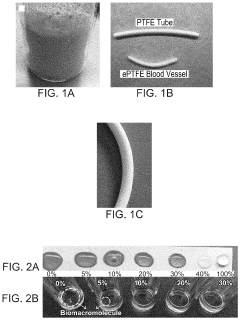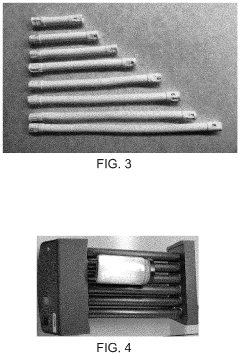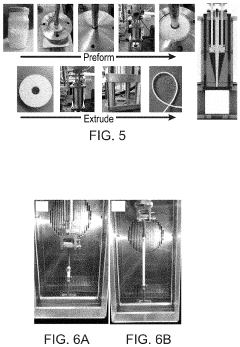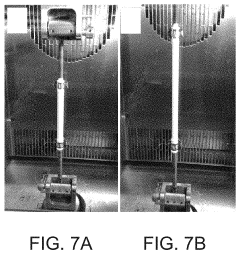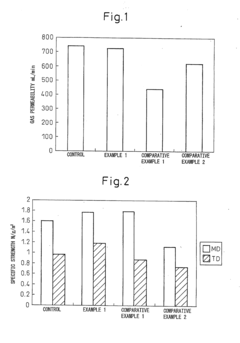Enhancing Efficiency in Industrial Processes with PTFE
JUN 27, 20259 MIN READ
Generate Your Research Report Instantly with AI Agent
Patsnap Eureka helps you evaluate technical feasibility & market potential.
PTFE in Industry: Background and Objectives
Polytetrafluoroethylene (PTFE), commonly known as Teflon, has been a revolutionary material in industrial processes since its accidental discovery by Roy Plunkett in 1938. This synthetic fluoropolymer has played a pivotal role in enhancing efficiency across various industrial sectors due to its unique properties, including high chemical resistance, low friction coefficient, and excellent thermal stability.
The evolution of PTFE in industrial applications has been marked by continuous innovation and expansion into diverse fields. Initially utilized in military and aerospace applications during World War II, PTFE's potential for improving industrial processes became increasingly apparent in the post-war era. The material's non-stick properties led to its widespread adoption in cookware, but its impact on industrial efficiency extends far beyond the kitchen.
In the realm of industrial processes, PTFE has emerged as a game-changer for several reasons. Its exceptional chemical resistance allows for the handling of corrosive substances without degradation, significantly extending the lifespan of equipment and reducing maintenance costs. The low friction coefficient of PTFE has revolutionized the design of bearings, seals, and gaskets, minimizing wear and tear on machinery and consequently improving overall operational efficiency.
The thermal stability of PTFE, maintaining its properties at temperatures ranging from -200°C to +260°C, has made it indispensable in high-temperature industrial applications. This characteristic has enabled the development of more efficient heat exchangers, insulation materials, and process equipment capable of withstanding extreme conditions.
As industries worldwide face increasing pressure to improve efficiency, reduce environmental impact, and enhance product quality, the role of PTFE in industrial processes has become more critical than ever. The material's ability to contribute to energy savings, reduce waste, and improve product purity aligns perfectly with these global industrial objectives.
The primary goal of exploring PTFE's potential in enhancing industrial efficiency is multifaceted. It involves identifying novel applications, developing advanced PTFE-based composites, and optimizing existing processes to leverage the material's unique properties fully. Additionally, there is a growing focus on sustainable manufacturing and application of PTFE, addressing concerns about its environmental impact and exploring bio-based alternatives.
As we delve deeper into the potential of PTFE for enhancing industrial efficiency, it is crucial to consider the material's entire lifecycle, from production to disposal or recycling. This comprehensive approach aims to maximize the benefits of PTFE while minimizing any potential drawbacks, ensuring a sustainable and efficient future for industrial processes.
The evolution of PTFE in industrial applications has been marked by continuous innovation and expansion into diverse fields. Initially utilized in military and aerospace applications during World War II, PTFE's potential for improving industrial processes became increasingly apparent in the post-war era. The material's non-stick properties led to its widespread adoption in cookware, but its impact on industrial efficiency extends far beyond the kitchen.
In the realm of industrial processes, PTFE has emerged as a game-changer for several reasons. Its exceptional chemical resistance allows for the handling of corrosive substances without degradation, significantly extending the lifespan of equipment and reducing maintenance costs. The low friction coefficient of PTFE has revolutionized the design of bearings, seals, and gaskets, minimizing wear and tear on machinery and consequently improving overall operational efficiency.
The thermal stability of PTFE, maintaining its properties at temperatures ranging from -200°C to +260°C, has made it indispensable in high-temperature industrial applications. This characteristic has enabled the development of more efficient heat exchangers, insulation materials, and process equipment capable of withstanding extreme conditions.
As industries worldwide face increasing pressure to improve efficiency, reduce environmental impact, and enhance product quality, the role of PTFE in industrial processes has become more critical than ever. The material's ability to contribute to energy savings, reduce waste, and improve product purity aligns perfectly with these global industrial objectives.
The primary goal of exploring PTFE's potential in enhancing industrial efficiency is multifaceted. It involves identifying novel applications, developing advanced PTFE-based composites, and optimizing existing processes to leverage the material's unique properties fully. Additionally, there is a growing focus on sustainable manufacturing and application of PTFE, addressing concerns about its environmental impact and exploring bio-based alternatives.
As we delve deeper into the potential of PTFE for enhancing industrial efficiency, it is crucial to consider the material's entire lifecycle, from production to disposal or recycling. This comprehensive approach aims to maximize the benefits of PTFE while minimizing any potential drawbacks, ensuring a sustainable and efficient future for industrial processes.
Market Demand Analysis for PTFE Solutions
The global market for PTFE (Polytetrafluoroethylene) solutions in industrial processes has been experiencing significant growth, driven by the increasing demand for high-performance materials in various sectors. The unique properties of PTFE, including its exceptional chemical resistance, low friction coefficient, and high temperature stability, make it an invaluable material for enhancing efficiency in industrial applications.
In the chemical processing industry, there is a growing need for PTFE-lined equipment and components due to its superior corrosion resistance. This demand is particularly strong in regions with rapidly expanding chemical manufacturing capabilities, such as Asia-Pacific and the Middle East. The oil and gas sector also presents a substantial market for PTFE solutions, especially in offshore drilling operations where harsh environmental conditions necessitate the use of highly durable materials.
The automotive industry has been increasingly adopting PTFE-based components to improve fuel efficiency and reduce emissions. As global automotive production continues to rise, particularly in emerging markets, the demand for PTFE solutions in this sector is expected to grow significantly. Similarly, the aerospace industry's pursuit of lightweight, high-performance materials has led to an increased utilization of PTFE in various applications, from seals and gaskets to wire insulation.
In the food processing industry, PTFE's non-stick properties and FDA compliance have made it a preferred material for conveyor belts, seals, and other food-contact surfaces. The growing emphasis on food safety and hygiene standards worldwide is driving the adoption of PTFE solutions in this sector. Additionally, the pharmaceutical industry's need for chemically inert materials in drug manufacturing processes has created a steady demand for PTFE-based equipment and components.
The electronics industry represents another significant market for PTFE solutions, particularly in the production of high-frequency circuit boards and semiconductor manufacturing equipment. As the global demand for electronic devices continues to surge, the market for PTFE in this sector is expected to expand considerably. Furthermore, the growing focus on renewable energy sources has opened up new opportunities for PTFE applications in solar panel manufacturing and wind turbine components.
Market analysts project that the global PTFE market will continue to grow at a compound annual growth rate (CAGR) of around 6% over the next five years. This growth is attributed to the material's expanding applications across various industries and the ongoing technological advancements in PTFE manufacturing processes. However, the market also faces challenges, including the high cost of PTFE compared to alternative materials and environmental concerns related to its production and disposal.
In the chemical processing industry, there is a growing need for PTFE-lined equipment and components due to its superior corrosion resistance. This demand is particularly strong in regions with rapidly expanding chemical manufacturing capabilities, such as Asia-Pacific and the Middle East. The oil and gas sector also presents a substantial market for PTFE solutions, especially in offshore drilling operations where harsh environmental conditions necessitate the use of highly durable materials.
The automotive industry has been increasingly adopting PTFE-based components to improve fuel efficiency and reduce emissions. As global automotive production continues to rise, particularly in emerging markets, the demand for PTFE solutions in this sector is expected to grow significantly. Similarly, the aerospace industry's pursuit of lightweight, high-performance materials has led to an increased utilization of PTFE in various applications, from seals and gaskets to wire insulation.
In the food processing industry, PTFE's non-stick properties and FDA compliance have made it a preferred material for conveyor belts, seals, and other food-contact surfaces. The growing emphasis on food safety and hygiene standards worldwide is driving the adoption of PTFE solutions in this sector. Additionally, the pharmaceutical industry's need for chemically inert materials in drug manufacturing processes has created a steady demand for PTFE-based equipment and components.
The electronics industry represents another significant market for PTFE solutions, particularly in the production of high-frequency circuit boards and semiconductor manufacturing equipment. As the global demand for electronic devices continues to surge, the market for PTFE in this sector is expected to expand considerably. Furthermore, the growing focus on renewable energy sources has opened up new opportunities for PTFE applications in solar panel manufacturing and wind turbine components.
Market analysts project that the global PTFE market will continue to grow at a compound annual growth rate (CAGR) of around 6% over the next five years. This growth is attributed to the material's expanding applications across various industries and the ongoing technological advancements in PTFE manufacturing processes. However, the market also faces challenges, including the high cost of PTFE compared to alternative materials and environmental concerns related to its production and disposal.
PTFE Technology: Current State and Challenges
Polytetrafluoroethylene (PTFE), commonly known as Teflon, has been a revolutionary material in industrial processes since its accidental discovery in 1938. Its unique properties, including high chemical resistance, low friction coefficient, and excellent thermal stability, have made it indispensable in various industries. However, the current state of PTFE technology faces several challenges that limit its full potential in enhancing industrial efficiency.
One of the primary challenges is the difficulty in processing PTFE due to its high melting point and viscosity. Traditional manufacturing methods, such as sintering and ram extrusion, are time-consuming and energy-intensive, leading to increased production costs and reduced efficiency. This limitation has spurred research into advanced processing techniques, such as electrostatic spinning and 3D printing of PTFE, which show promise but are still in their early stages of development.
Another significant challenge is the environmental impact of PTFE production and disposal. The use of perfluorooctanoic acid (PFOA) in PTFE manufacturing has raised concerns due to its persistence in the environment and potential health risks. While many manufacturers have phased out PFOA, finding equally effective and environmentally friendly alternatives remains an ongoing challenge.
The modification of PTFE to enhance its properties for specific applications is another area of focus. While PTFE's inherent characteristics are valuable, there is a growing demand for tailored properties such as improved wear resistance, enhanced thermal conductivity, or better adhesion to other materials. Researchers are exploring various methods, including the incorporation of nanoparticles and surface treatments, to achieve these modifications without compromising PTFE's core benefits.
In the realm of industrial processes, the integration of PTFE components into complex systems presents its own set of challenges. Issues such as sealing in high-pressure environments, maintaining performance under extreme temperatures, and ensuring long-term reliability in corrosive conditions are areas where current PTFE technology is being pushed to its limits. Innovations in composite materials and hybrid designs are being pursued to address these challenges.
The recycling and reuse of PTFE products also pose significant technical and economic challenges. Unlike many other plastics, PTFE cannot be easily melted and reformed, making traditional recycling methods ineffective. Developing efficient recycling processes for PTFE is crucial for improving its sustainability profile and reducing waste in industrial applications.
As industries continue to demand higher performance materials, the development of next-generation fluoropolymers that build upon PTFE's strengths while addressing its limitations is an active area of research. These efforts aim to create materials that offer even greater chemical resistance, improved processability, and enhanced mechanical properties to further boost industrial efficiency.
One of the primary challenges is the difficulty in processing PTFE due to its high melting point and viscosity. Traditional manufacturing methods, such as sintering and ram extrusion, are time-consuming and energy-intensive, leading to increased production costs and reduced efficiency. This limitation has spurred research into advanced processing techniques, such as electrostatic spinning and 3D printing of PTFE, which show promise but are still in their early stages of development.
Another significant challenge is the environmental impact of PTFE production and disposal. The use of perfluorooctanoic acid (PFOA) in PTFE manufacturing has raised concerns due to its persistence in the environment and potential health risks. While many manufacturers have phased out PFOA, finding equally effective and environmentally friendly alternatives remains an ongoing challenge.
The modification of PTFE to enhance its properties for specific applications is another area of focus. While PTFE's inherent characteristics are valuable, there is a growing demand for tailored properties such as improved wear resistance, enhanced thermal conductivity, or better adhesion to other materials. Researchers are exploring various methods, including the incorporation of nanoparticles and surface treatments, to achieve these modifications without compromising PTFE's core benefits.
In the realm of industrial processes, the integration of PTFE components into complex systems presents its own set of challenges. Issues such as sealing in high-pressure environments, maintaining performance under extreme temperatures, and ensuring long-term reliability in corrosive conditions are areas where current PTFE technology is being pushed to its limits. Innovations in composite materials and hybrid designs are being pursued to address these challenges.
The recycling and reuse of PTFE products also pose significant technical and economic challenges. Unlike many other plastics, PTFE cannot be easily melted and reformed, making traditional recycling methods ineffective. Developing efficient recycling processes for PTFE is crucial for improving its sustainability profile and reducing waste in industrial applications.
As industries continue to demand higher performance materials, the development of next-generation fluoropolymers that build upon PTFE's strengths while addressing its limitations is an active area of research. These efforts aim to create materials that offer even greater chemical resistance, improved processability, and enhanced mechanical properties to further boost industrial efficiency.
Current PTFE-based Efficiency Enhancement Methods
01 PTFE membrane efficiency in filtration
PTFE membranes are highly efficient in filtration processes due to their unique properties. These membranes offer excellent chemical resistance, high temperature tolerance, and low surface energy, making them ideal for various filtration applications. The porous structure of PTFE membranes allows for high flow rates while maintaining excellent particle retention, enhancing overall filtration efficiency.- PTFE membrane efficiency in filtration: PTFE membranes are highly efficient in filtration processes due to their unique properties. These membranes offer excellent chemical resistance, high porosity, and low surface energy, making them ideal for various filtration applications. The efficiency of PTFE membranes can be further enhanced by modifying their structure or combining them with other materials to improve their performance in specific filtration tasks.
- PTFE coatings for improved surface properties: PTFE coatings are utilized to enhance surface properties of various materials. These coatings provide excellent non-stick characteristics, low friction, and high chemical resistance. The efficiency of PTFE coatings can be improved by optimizing the coating process, adjusting the thickness, or incorporating additives to enhance specific properties such as wear resistance or thermal conductivity.
- PTFE in composite materials for enhanced performance: PTFE is incorporated into composite materials to improve their overall performance. By combining PTFE with other materials such as fibers, resins, or nanoparticles, the resulting composites can exhibit enhanced properties like increased strength, improved thermal stability, or better electrical insulation. The efficiency of these PTFE-based composites can be optimized by adjusting the composition and manufacturing processes.
- PTFE in energy-efficient applications: PTFE is utilized in various energy-efficient applications due to its unique properties. Its low friction coefficient and high thermal stability make it suitable for use in energy-saving components such as bearings, seals, and insulation materials. The efficiency of PTFE in these applications can be improved by optimizing its formulation, processing techniques, or combining it with other materials to enhance specific energy-saving properties.
- PTFE recycling and sustainability: Efforts are being made to improve the efficiency of PTFE recycling and enhance its sustainability. This includes developing new methods for recycling PTFE waste, finding ways to reuse recycled PTFE in various applications, and creating more environmentally friendly PTFE production processes. These advancements aim to reduce the environmental impact of PTFE while maintaining its valuable properties and efficiency in various applications.
02 PTFE coatings for improved surface properties
PTFE coatings are utilized to enhance surface properties of various materials. These coatings provide low friction, non-stick characteristics, and improved wear resistance. The efficiency of PTFE coatings is demonstrated in applications such as cookware, industrial equipment, and automotive components, where they significantly reduce friction and improve durability.Expand Specific Solutions03 PTFE in energy-efficient applications
PTFE's unique properties contribute to energy efficiency in various applications. Its low coefficient of friction reduces energy loss in mechanical systems, while its excellent insulating properties make it valuable in electrical and thermal applications. PTFE-based materials are used in energy-efficient heat exchangers, fuel cells, and solar panels, improving overall system performance.Expand Specific Solutions04 PTFE composites for enhanced performance
PTFE composites combine the beneficial properties of PTFE with other materials to create high-performance products. These composites often exhibit improved mechanical strength, wear resistance, and thermal stability compared to pure PTFE. The efficiency of PTFE composites is evident in applications such as seals, bearings, and industrial components, where they offer extended service life and reduced maintenance requirements.Expand Specific Solutions05 PTFE in water and oil repellent treatments
PTFE-based treatments are highly efficient in imparting water and oil repellency to various surfaces. These treatments create a low surface energy barrier that repels liquids, making them valuable in textile, paper, and building material applications. The efficiency of PTFE in water and oil repellent treatments is demonstrated by their long-lasting performance and resistance to washing and weathering.Expand Specific Solutions
Key Players in PTFE Manufacturing and Innovation
The industrial process efficiency enhancement using PTFE is in a mature stage, with a well-established market and significant technological advancements. The global PTFE market size is substantial, driven by diverse applications across industries. Major players like DuPont, Chemours, and Daikin have developed advanced PTFE formulations and processing techniques, demonstrating high technological maturity. Companies such as W. L. Gore & Associates and AGC have further innovated with PTFE-based products for specialized applications. Academic institutions like ETH Zurich and Zhejiang University contribute to ongoing research, while smaller firms like Shamrock Technologies focus on niche PTFE applications, indicating a competitive and evolving landscape.
DuPont de Nemours, Inc.
Technical Solution: DuPont has developed advanced PTFE formulations and processing techniques to enhance industrial efficiency. Their Teflon™ PTFE fluoropolymer resins offer exceptional chemical resistance and low friction properties[1]. DuPont's innovative PTFE micropowders, such as Zonyl™ MP1100, are designed for use in high-performance coatings and inks, improving wear resistance and reducing friction in industrial applications[2]. The company has also introduced PTFE-based composite materials that combine the benefits of PTFE with other polymers or fillers, resulting in materials with enhanced mechanical properties and thermal stability[3]. These advancements allow for improved equipment longevity, reduced maintenance costs, and increased production efficiency in various industrial processes.
Strengths: Extensive R&D capabilities, wide range of PTFE products for diverse applications, and strong brand recognition. Weaknesses: Higher costs compared to some competitors, potential environmental concerns associated with fluoropolymer production.
The Chemours Co.
Technical Solution: Chemours has developed a range of PTFE products under the Teflon™ brand to enhance industrial efficiency. Their Teflon™ PTFE fluoropolymer resins offer exceptional chemical resistance, low friction, and high-temperature stability[4]. Chemours has introduced innovative PTFE micropowders, such as Teflon™ PTFE TE-3893N, designed for use in high-performance coatings and lubricants, improving wear resistance and reducing friction in industrial applications[5]. The company has also developed PTFE-based composite materials that combine PTFE with other polymers or fillers, resulting in materials with enhanced mechanical properties and thermal stability for demanding industrial environments[6]. These advancements contribute to improved equipment longevity, reduced maintenance costs, and increased production efficiency across various industrial sectors.
Strengths: Strong brand recognition with Teflon™, diverse PTFE product portfolio, and significant market presence. Weaknesses: Environmental concerns related to fluoropolymer production, potential regulatory challenges.
Core Innovations in PTFE Material Science
Green fabrication of polytetrafluoroethylene and expanded polytetrafluoroethylene and uses thereof
PatentActiveUS20220251324A1
Innovation
- The use of lower alkyl alcohols, such as ethanol, as alternative lubricants for processing PTFE and ePTFE, which allows for safe evaporation and incorporation of biofunctional molecules during processing, enabling the creation of safer and more versatile products.
Method for producing porous film or tape of expanded polytetrafluoroethylene supporting catalyst particles, and ozone-removing filter
PatentActiveUS20120164035A1
Innovation
- A method involving the preparation of tape-like PTFE, impregnation with catalyst particles, and subsequent stretching in the machine and transverse directions to minimize defects and enhance strength, allowing for high-ratio stretching and stable pore size maintenance.
Environmental Impact of PTFE in Industrial Processes
The environmental impact of PTFE in industrial processes is a critical consideration as industries strive to enhance efficiency while maintaining sustainability. PTFE, or polytetrafluoroethylene, is widely used in various industrial applications due to its unique properties, including chemical resistance, low friction, and high temperature tolerance. However, its production and use have significant environmental implications that must be carefully evaluated.
The manufacturing process of PTFE involves the use of fluoropolymers, which can contribute to greenhouse gas emissions. The production of PTFE requires the use of perfluorooctanoic acid (PFOA) or other perfluorinated compounds, which are persistent organic pollutants. These substances have been linked to environmental contamination and potential health risks, raising concerns about their long-term impact on ecosystems and human well-being.
In industrial processes, PTFE coatings and components can significantly improve efficiency by reducing friction, preventing corrosion, and extending equipment lifespan. This increased efficiency can lead to reduced energy consumption and lower overall environmental impact during operation. However, the disposal of PTFE-containing products at the end of their lifecycle presents challenges, as the material is not biodegradable and can persist in the environment for extended periods.
Efforts to mitigate the environmental impact of PTFE in industrial processes have led to the development of alternative manufacturing methods and materials. Some companies have invested in PFOA-free production techniques, while others are exploring bio-based alternatives that offer similar properties to PTFE but with a reduced environmental footprint.
The recycling of PTFE products is another area of focus for reducing environmental impact. While challenging due to the material's chemical stability, advancements in recycling technologies are making it increasingly feasible to recover and reuse PTFE from industrial applications. This circular approach can help minimize waste and reduce the demand for new PTFE production.
As industries continue to rely on PTFE for its exceptional properties, balancing efficiency gains with environmental considerations remains crucial. Ongoing research and development efforts are focused on improving the sustainability of PTFE production and use, including the exploration of green chemistry principles and the development of more environmentally friendly fluoropolymers.
The manufacturing process of PTFE involves the use of fluoropolymers, which can contribute to greenhouse gas emissions. The production of PTFE requires the use of perfluorooctanoic acid (PFOA) or other perfluorinated compounds, which are persistent organic pollutants. These substances have been linked to environmental contamination and potential health risks, raising concerns about their long-term impact on ecosystems and human well-being.
In industrial processes, PTFE coatings and components can significantly improve efficiency by reducing friction, preventing corrosion, and extending equipment lifespan. This increased efficiency can lead to reduced energy consumption and lower overall environmental impact during operation. However, the disposal of PTFE-containing products at the end of their lifecycle presents challenges, as the material is not biodegradable and can persist in the environment for extended periods.
Efforts to mitigate the environmental impact of PTFE in industrial processes have led to the development of alternative manufacturing methods and materials. Some companies have invested in PFOA-free production techniques, while others are exploring bio-based alternatives that offer similar properties to PTFE but with a reduced environmental footprint.
The recycling of PTFE products is another area of focus for reducing environmental impact. While challenging due to the material's chemical stability, advancements in recycling technologies are making it increasingly feasible to recover and reuse PTFE from industrial applications. This circular approach can help minimize waste and reduce the demand for new PTFE production.
As industries continue to rely on PTFE for its exceptional properties, balancing efficiency gains with environmental considerations remains crucial. Ongoing research and development efforts are focused on improving the sustainability of PTFE production and use, including the exploration of green chemistry principles and the development of more environmentally friendly fluoropolymers.
Cost-Benefit Analysis of PTFE Implementation
The implementation of PTFE (Polytetrafluoroethylene) in industrial processes requires a comprehensive cost-benefit analysis to determine its economic viability and long-term impact on operational efficiency. This analysis encompasses both direct and indirect costs associated with PTFE integration, as well as the potential benefits and returns on investment.
Initial costs for PTFE implementation include the purchase of PTFE materials, equipment modifications or upgrades to accommodate PTFE components, and potential production downtime during installation. These upfront expenses can be significant, particularly for large-scale industrial operations. However, it is crucial to consider these costs in the context of long-term savings and efficiency gains.
One of the primary benefits of PTFE implementation is its potential to reduce maintenance costs and frequency. PTFE's non-stick and low-friction properties contribute to decreased wear and tear on machinery, resulting in extended equipment lifespan and reduced replacement costs. This can lead to substantial savings in maintenance budgets over time.
Energy efficiency improvements represent another significant benefit of PTFE integration. The material's low coefficient of friction can reduce power consumption in various industrial processes, particularly those involving moving parts or fluid handling. These energy savings can translate into lower operational costs and improved environmental performance.
PTFE's chemical resistance and thermal stability contribute to enhanced process reliability and reduced downtime. This increased uptime can lead to higher production output and improved overall equipment effectiveness (OEE), directly impacting the bottom line. Additionally, the material's non-reactive nature can help maintain product purity, potentially reducing waste and improving yield rates.
When evaluating the cost-benefit ratio, it is essential to consider the specific application and industry context. For example, in chemical processing or food production, the benefits of PTFE's non-stick and chemical-resistant properties may outweigh the implementation costs more quickly than in other industries. The analysis should also factor in potential regulatory compliance benefits, such as improved safety measures or reduced environmental impact.
Long-term cost savings from PTFE implementation can be substantial, but they may take time to materialize fully. A thorough ROI calculation should account for the expected lifespan of PTFE components and the cumulative benefits over this period. This analysis should also consider potential indirect benefits, such as improved product quality, enhanced customer satisfaction, and potential market differentiation resulting from more efficient and reliable processes.
In conclusion, while the initial investment in PTFE implementation can be significant, the potential for long-term cost savings, efficiency improvements, and operational benefits often justifies the expense. A detailed, industry-specific cost-benefit analysis is crucial for making informed decisions about PTFE integration in industrial processes.
Initial costs for PTFE implementation include the purchase of PTFE materials, equipment modifications or upgrades to accommodate PTFE components, and potential production downtime during installation. These upfront expenses can be significant, particularly for large-scale industrial operations. However, it is crucial to consider these costs in the context of long-term savings and efficiency gains.
One of the primary benefits of PTFE implementation is its potential to reduce maintenance costs and frequency. PTFE's non-stick and low-friction properties contribute to decreased wear and tear on machinery, resulting in extended equipment lifespan and reduced replacement costs. This can lead to substantial savings in maintenance budgets over time.
Energy efficiency improvements represent another significant benefit of PTFE integration. The material's low coefficient of friction can reduce power consumption in various industrial processes, particularly those involving moving parts or fluid handling. These energy savings can translate into lower operational costs and improved environmental performance.
PTFE's chemical resistance and thermal stability contribute to enhanced process reliability and reduced downtime. This increased uptime can lead to higher production output and improved overall equipment effectiveness (OEE), directly impacting the bottom line. Additionally, the material's non-reactive nature can help maintain product purity, potentially reducing waste and improving yield rates.
When evaluating the cost-benefit ratio, it is essential to consider the specific application and industry context. For example, in chemical processing or food production, the benefits of PTFE's non-stick and chemical-resistant properties may outweigh the implementation costs more quickly than in other industries. The analysis should also factor in potential regulatory compliance benefits, such as improved safety measures or reduced environmental impact.
Long-term cost savings from PTFE implementation can be substantial, but they may take time to materialize fully. A thorough ROI calculation should account for the expected lifespan of PTFE components and the cumulative benefits over this period. This analysis should also consider potential indirect benefits, such as improved product quality, enhanced customer satisfaction, and potential market differentiation resulting from more efficient and reliable processes.
In conclusion, while the initial investment in PTFE implementation can be significant, the potential for long-term cost savings, efficiency improvements, and operational benefits often justifies the expense. A detailed, industry-specific cost-benefit analysis is crucial for making informed decisions about PTFE integration in industrial processes.
Unlock deeper insights with Patsnap Eureka Quick Research — get a full tech report to explore trends and direct your research. Try now!
Generate Your Research Report Instantly with AI Agent
Supercharge your innovation with Patsnap Eureka AI Agent Platform!
